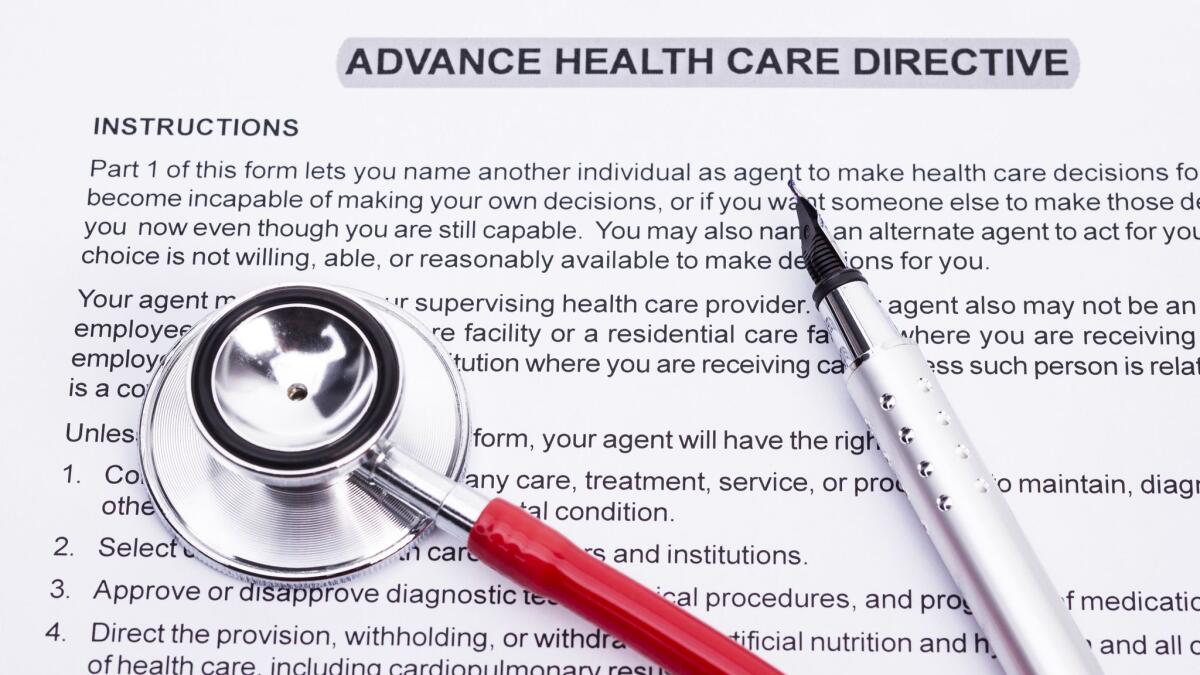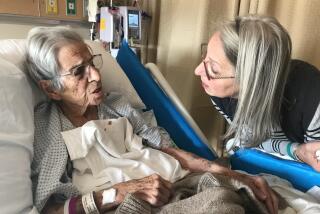Op-Ed: Why you should make end-of-life care decisions now

Modern medicine has developed the God-like power to stabilize the vital signs that spiral out of control as a person approaches death, and to then keep that person alive despite their inability to breathe, eat or drink. It wields this power liberally.
But the American healthcare system never taught the public that preventing a natural death often results in a wholly unnatural life.
As an ICU nurse, I am haunted by memories of patients who were stabilized in intensive care so that their catastrophic injuries or diseases did not kill them, but who were left unable to communicate or do anything but receive medical care.
I think of a young woman whose family was so torn apart over whether to take her off life support after a hemorrhagic stroke left her comatose that by the time she died of a complication, weeks later, nobody came to be by her side.
The incapacitated ill are profoundly disenfranchised, and the manipulation of their bodies is extraordinarily invasive and consequential.
When she was first admitted to the hospital, her family crowded her room. But when she didn’t get better, they drifted away. She stayed, her flesh peachy after weeks of tube feeding, though speckled with the tiny bruises of blood-thinning heparin shots.
She died of a perforated bowel leaking fecal matter into her abdomen and causing sepsis. Her family had declined emergency surgery over the telephone, giving permission for her to die. At the very end, there was only a nurse, dialing up morphine as the patient’s organs failed.
I can only imagine the immense suffering her family endured, and I know that every time they were asked for a decision regarding her care, they tried to make the right one.
But I wonder: If what was left of the girl in the hospital wasn’t enough to come say goodbye to, if she was too far gone to hold hands with as she drew her last breaths, why was she still there?
I also think of an elderly patient with a history of strokes and dementia who was brought to the emergency department after another large stroke. He was already completely immobile, dependent on care and unable to communicate. His breathing was inadequate and his heart went into a dangerous rhythm — dangerous if the goal is to stay alive. He was intubated and taken to the ICU.
The poor man was awake. He would occasionally squeeze a hand when asked to, but he never responded to questions. Because there was no fear of him pulling out his breathing tube, he was on minimal sedation, getting drugs only when he breathed rapidly or started “bugging out his eyes,” as one nurse put it. Aside from a list of diagnoses and meds, there was little information in his history, and no family contacts.
When asked directly by the ICU, the patient’s case manager and his general physician both refused to serve as his proxy and would not participate in a conversation about whether the patient would rather switch from life-sustaining measures to “comfort care,” which would have meant removing the plastic tube from his trachea and allowing him to die naturally, with supportive care and medicine to make him comfortable. So we kept him alive.
When I am face to face with a patient like this — someone who will never again be able to communicate, and who has been placed on the treadmill of continuous medical care — I feel the same type of shame as when I walk by a cold, crippled homeless person on the sidewalk. The wrongness is just as obvious.
When I stick a needle into his arm, or a catheter into his urethra, it feels as though I am kicking a homeless person. The incapacitated ill are profoundly disenfranchised, and the manipulation of their bodies is extraordinarily invasive and consequential.
It’s a moral crisis hiding in plain sight, yet the people involved claim to be mere cogs in the machine. When I asked an ICU attending physician why families aren’t given data and clear explanations of probable outcomes rather than best-case scenarios and “only time will tell” conversations, he said, “palliative care people can do that. In the ICU, we don’t really have time.” Another physician mentioned the “inertia of the system.”
It falls to the general public — the patients — to take the initiative in reforming the excesses of modern medical care.
You can determine your fate by completing an advance directive. This is a legal document in which you can explain what measures should be undertaken if you are unable to communicate; name a healthcare proxy who can communicate your wishes to medical providers; and lay out how you envision the end of your life.
Medicare began reimbursing physicians for advanced care planning in 2016. And many states have adopted POLST programs — Physician Orders for Life Sustaining Treatment — in which medical orders can be written in advance. Still, two-thirds of Americans do not have any type of advance directive in place.
These documents are critically important. If you don’t want to be kept alive on life support, you can indicate as much in your advance directive. If you want the longest life possible no matter what, you can affirm this wish. Either way, families and care providers should know. It will help move our medical system toward a more humane approach to end-of-life care.
Kristen McConnell, a nurse and writer, is working on a memoir about the culture of intensive care.
Follow the Opinion section on Twitter @latimesopinion or Facebook.
More to Read
A cure for the common opinion
Get thought-provoking perspectives with our weekly newsletter.
You may occasionally receive promotional content from the Los Angeles Times.






